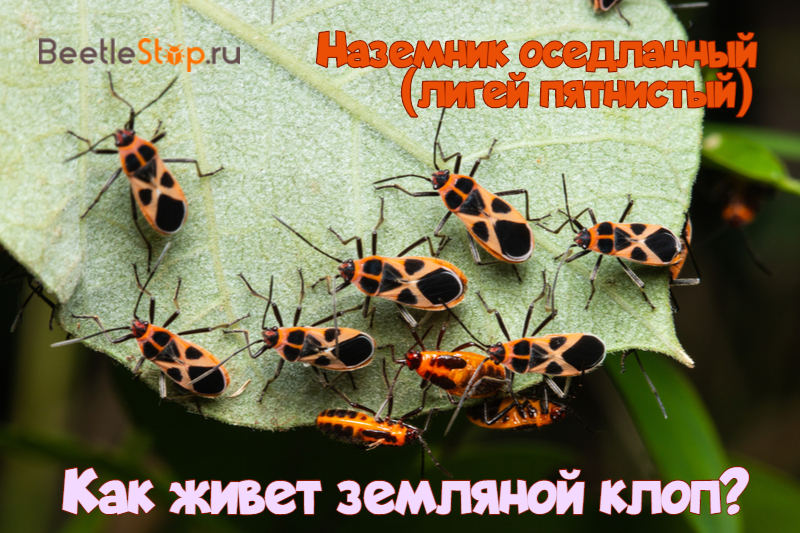A landlord saddled - to be afraid or not a red-black bug?
A large family of earthen bugs or terrestrial (Lygaeidae) belongs to the order of semi-rigid bugs. A characteristic feature of insects is a flattened body, small size and dark color. Among 4 thousand species of the family, there are bugs with a bright contrasting color - red-black or red-yellow. One of them is a saddleman. This phytophage feeds on buds, ovaries and seeds of herbaceous plants.

Morphological description of the species
A landlord saddled or spotted league (Lygaeus tguestris) is a representative of the squadron, the family of terrestrial. The bug is medium sized, length 10-12 mm. body oblong-oval, slightly flattened from above. The head is red, eyes are large, facet type, spherical in shape. There are black spots around the eyes. The oral apparatus is a piercing-sucking type, presented in the form of a jointed muscular proboscis. At rest, the organ is bent under the head and chest.
Interesting fact. The landman saddled in red and black is similar to a soldier bug. The presence of wings in spotted ligia is a distinctive feature.
The shield has the shape of a trapezoid, expanding towards the back, rounded at the sides. The main color is red, near the base is a large black spot. The head and pronotum are covered with short blond hairs. The thoracic part is black. Abdomen red with dark spots on the sides and bottom. It has three pairs of long strong legs of a traveling type.
The front wings of insects are half hard, leathery. This part is red with two black bandages and spots. The edges of the wings are membranous, darkened with a round white spot. The hind pair of wings is shorter, but wider than the front. When folding, the transparent hind wings are at the bottom.
There are two subspecies of beetles:
- Lygaeuse equestris equestris (found by C. Linnaeus in 1758);
- Lygaeuse equestris sicilianus (described by Wagner in 1955).
Lifestyle & Reproduction
Insects are found in forest glades, in shrubs, on lawns. Spotted lighei prefers warm sunny areas on calcareous soils. In the spring, with the onset of a stable positive temperature, overwintered bugs appear at old stumps and tree trunks. In the garden or on the forest floor, you can notice an accumulation of red-black insects basking in the first rays of the sun. The first food of the landlord saddled is very scarce, it is dry leaves. With the advent of the first dandelions, he moves to yellow flowers.
Over a year, one generation of earthen bugs is developing. These insects are distinguished by an incomplete development cycle; the pupal stage is absent. The larva is called a nymph.
Breeding
Mating terrestrial occurs in the spring on plants, stones or in the grass. Partners find a friend for each other according to the emitted smell containing pheromones. Male and female are connected by the posterior ends of the abdomen. The fertilized partner lays eggs on the lower part of the leaves of fodder plants or in the soil to a depth of 1-3 cm. In one clutch, 20-50 eggs, for the life of the female, the fertility of the female is up to 500 pieces. Grayish-white eggs in the shape of cylinders. Of the numerous masonry, no more than half of the viable embryos remain.
Information. The mating process of a saddled sturgeon lasts up to 24 hours.
The development of offspring takes 35-40 days.During this time, nymphs succeed five ages. At the beginning, they are red, elytra in its infancy, enlarged abdomen. With each skinning, the larvae become more like adult flying individuals.
Larvae feed on caustic sap of milk and dandelion, seeds of spring adonis, sunflower. Euphorbia and adonis (adonis) are poisonous herbs for many animals, and the motley league without consequences feeds on them all their lives. A peculiar diet makes the hemolymph (blood) of the bug dangerous. Nature took care of the protective mechanism of the groundman and signals for those around him. Red-black coloring is a warning sign for birds of prey, insects, reptiles that can attack spotted ligia.
Distribution area
Rider saddled belongs to the trans-arctic species. Distributed along the northern border to Norway, Sweden, Finland. Bed bugs live in Central, Western and Eastern Europe, India and Japan. The species is common in Russia, reaches the southern edge of the taiga.
Peculiarities of nutrition and harmfulness
Bed bugs of the species Lygaeus tguestris are often found in gardens and vegetable gardens. Nymphs and adults pierce buds, immature seeds and leaves to nourish plant sap. Insects appear in small numbers and do not cause significant harm to ornamental and agricultural crops. In some cases, bedbugs spoil cauliflower.


I'm afraid of this bug, I have a phobia on them